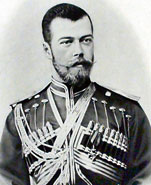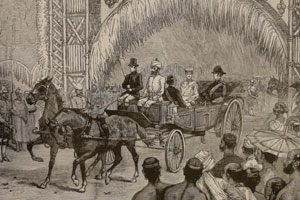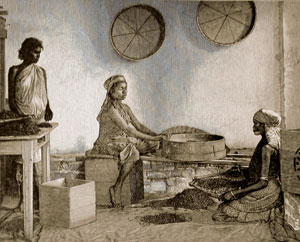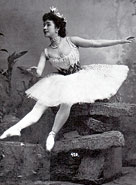The final years of Tsarist Russia were tumultuous and violent. The October 1917 revolution, the civil war between the Bolsheviks and White Tsarist forces, and the execution of Tsar Nicholas II and his family in 1918 were far away from the halcyon Ceylonese days of 1891 when Nicholas (Nicky), then the Tsarevitch, the heir to the Russian thronek1planted a tree in the Royal Botanical Gardens near Kandy, and enjoyed tea served in a Russian style with Sir Solomon Dias Bandaranaike, the father of S.W.R.D. Bandaranaike, the Prime Minister of Ceylon from 1956 to 1959.
 |
Tsarevitch Nicholas II at the
time of his visit to Asia in 1891 |
His trip to Ceylon was part of a Grand Tour to the Far East which his father Tsar Alexander III had sent him on to complete his education, to get to know his future central Asian subjects, and to help him realise that Russia’s future interests were in Asia.
Writing in the 1930s, Princess Catherine Radziwill, a member of an old noble Russian family, claims the Tsar sent Nicholas to Asia to break up his relationship with his mistress, Mathilde Kschessinska the ballerina of the Maryinsky theatre in St. Petersburg after the two were involved in a scandal at the popular Cubat’s restaurant in St. Petersburg in the summer of 1890.
Nicky and Mathilde were drinking champagne with officers of his regiment and other ladies. At 2 a.m. the restaurant owner informed the Tsarevitch that city ordinances required him to close the club. Nicholas told him he was not interested in city ordinances and he continued to drink champagne. A policeman passing by Cubat’s noticed the lights were on and attempted to close the restaurant but was also pushed aside. General von Wahl, the President of the Police of St. Petersburg soon arrived but his presence led to an argument culminating in the Tsarevitch throwing a bowl of caviar at him.
In Imperial Dancer: Mathilde Kschessinska and the Romanovs (2005), Coryne Hall claims no evidence exists that Nicholas was sent to the Far East to separate him from his mistress as it appears in 1890 "the couple hardly knew each other" though there is no concrete evidence to support this contention. In fact, the two had met in the early 1890s and were contiguously attracted to each other, while Nicholas’ diary reveals he had argued with his father over his relationship with the seductive ballerina.
Nicholas left St. Petersburg in November 1890. He travelled through Eastern Europe, Austria, and to Trieste on the Adriatic Sea. Here, he boarded the Pamiat Azova, a Russian frigate with a crew of 580. He was joined by a miscellany of Grand Dukes, Princes, and naval officers. In Athens, Prince George of Greece joined the party. In Egypt, Nicholas and George visited the pyramids, took camel rides, and watched naked dancing girls. In the 32 days spent in India, Nicholas participated in tiger shoots and balls, collected artworks, and visited the Mint in Calcutta which supplied notes and coins to India, Ceylon, Singapore, and the Straits Settlements.
The Grand Dukes in Ceylon
It was 8 a.m. when the Pamiat Azova steamed into Colombo harbour on February 12, 1891. The Imperial party were met by a reception of boats but Nicholas had his eyes only on the yacht - the Tamara - on which Grand Dukes Alexander and Sergi Mikhailovich had sailed to Colombo to meet him. The two brothers had been travelling around India and Ceylon casting anchor in any cove or inlet that took their fancy, and often travelling inland to visit cities. In Colombo, Alexander and Sergi joined the Tsarevitch on his Ceylon tour. The Grand Dukes spent many hours with the Tsarevitch and Alexander was able to provide him with firsthand information collected on his travels in south Asia.
 |
| Bering's sketch of the reception for Tsarevitch Nicholas II in Colombo |
 |
| Tea sifting near Kandy |
Just after 10.30 a.m., the Governor of Ceylon, Sir Arthur Havelock, boarded the Pamiat Azova to welcome the Tsarevitch to Ceylon. The Imperial party came ashore at 4 p.m. Nicholas was greeted by local authorities and foreign diplomats. Their Highnesses were then driven along Church Street and Queen’s Street to the Governor’s residence for a state dinner at Queen’s House. A sketch by Mr. W. W. Bering of the Survey Department in Colombo shows the streets decorated with palm branches and crowded with people. Early next morning (February 13) the Imperial party with Sir Arthur Havelock travelled to Kandy. At Peradeniya, the party inspected a tea factory and were given a tour of the Royal Botanical Gardens by the Director, Dr. Henry Trimen. In Kandy a state dinner was held in the evening for the Imperial party. Then, at 10 p.m., from the library-tower of the Temple of the Tooth, their Highnesses witnessed a Perahera consisting of native chiefs in full dress, 30 to 40 elephants, and dancers, including "devil dancers."
Their Highnesses returned to the Temple of the Tooth the next morning for a private viewing of the Tooth Relic. At 10.40 a.m., the party boarded a train travelling south into the mountains, stopping at Hatton to spend an hour at the Darrawella racecourse. Here, the Chairman of the Ceylon Planters’ Association, Mr. L. H. Kelly, presented an album of photographs of Ceylon to the Tsarevitch. The party continued their journey to Nanu oya winding past deserted coffee plantations. Their Highnesses spent the next two days at Nuwara Eliya engaged in excursions and hunting.
On February 17, while travelling to Orugodawatta, the Imperial Party were the guests of Solomon Dias Bandaranaike at the Hanwella rest house. Bandaranaike, who likely organised the itinerary in Ceylon for the Imperial party, wrote about this encounter 28 years later in Remembered Yesterdays (1929). In describing his meeting with the Tsarevitch, Bandaranaike says, "The impression I received was that the Tsarevitch in his style and manners was utterly different to those members of the British royal family I had the honour of meeting."
Nicky’s elephant in Colombo
Their Highnesses spent the last part of their journey in Ceylon at a kraal in Labugama, near Colombo. This is of particular interest as it confirms that large numbers of elephants were roaming in the jungles not far from Colombo in the early 1890s. The kraal resulted in the noosing of nine elephants, including a baby elephant which was given to the Tsarevitch as a gift. As the elephant was too playful, it was left in the care of the Russian consul in Colombo, Mr. Frisch, for him to send to Russia later. But soon after the Imperial party left Ceylon on the 24th, the elephant ran amok as Prince Esper Ukhtomsky describes in his official account of the tour. He writes:
"[The elephant] one night cleverly untied the stout rope fastened round its neck, and began to run about the garden, breaking and trampling on everything in its path. The Consul, in night-shirt and slippers, ran out to catch the rebel, but the latter burst open the gates, upset Mr. Frisch twice, and ran off into the neighbouring marshy and thorny jungle. Mr. Frisch, having lost his slippers, manfully gave chase barefoot, accompanied by his servants. Meanwhile, the young elephant had returned to the inhabited regions, and again began its pranks on an elemental scale.
For example, it enjoyed a bath in a tank, attacked a Dutch merchant who was resting in his verandah [sic], throwing him several yards from his seat, damaged the furniture, and then ran off along the seaside road towards Mount Lavinia. Our Consul at last gave up the chase and hastened home for a horse, warning the police of the mishap which had taken place. [The police] armed with torches, overtook the little beast, which had already run some two miles. Blank cartridge was fired at it, and the terrified animal was surrounded under a tree, into which a native elephant-hunter climbed with a noose to drop over the fugitive. It was already dawn when a dozen policemen at least succeeded in dragging it home again. The Consulate paid a number of people for damage done and services rendered during this tragic-comic incident."
 |
Mathilde Kschessinska, the ballerina and
mistress of Tsarevitch Nicholas II. |
The Imperial party travelled to Singapore, Java, Siam, Saigon and Hong Kong. In Japan, the tour almost ended in tragedy. On May 11, the Imperial party were travelling by rickshaws through a narrow street in Otsu when a policeman, Tsudo Santso, leapt out, drew his sword and swung a two-handed blow on the Tsarevitch’s head. The blade sliced through his bowler hat - inflicting two cuts on his head.
Santso was raising his sword for a second blow but was overpowered by two rickshaw bearers and Prince George, who leapt from his rickshaw and struck the policeman from behind with a bamboo cane. According to the official Russian explanation for the attack, Santso had attempted to kill Nicholas because of his deep hatred of foreigners, and that as a samurai he had been insulted by the attention and honour the Tsarevitch had received in Japan.
Contradictions and criticisms
Nicholas’ visit to India and Ceylon reveals contradictions in his attitude towards the British. Though he admired the skill of the British to rule their colonies in Asia, he felt their policies were too aggressive. He attended official functions, met leading political and military figures, and sent a telegram to Queen Victoria praising Sir Arthur Havelock for his hospitality in Ceylon. Yet, privately he was critical of the British in south Asia.
In India, he wrote in his diary: "It is intolerable to be surrounded by Englishmen...and to see red uniforms everywhere." In Ceylon, he enjoyed visiting the tea factory near Kandy but criticised the British for growing tea in huge quantities and the relentless acquiring of wealth regardless of the risks, and that little of the wealth acquired went to assisting the Ceylonese improve their lives. Prince Esper Ukhtomsky, who accompanied Nicholas and tutored him in Asian studies, writes: "Energies of the European element are directed not towards the discovery of means for increasing the general prosperity of the [Ceylonese] islanders, but towards the pursuit of their own temporary ends, which promise a gigantic success one day, while the next may threaten them with ruin."
To understand these criticisms, we have to look to other factors, and other historical contexts as Tsarist Russia sought to expand its own interests in Asia in the great game being played out among European nations. It would be naive to think Tsarist Russia had sincere feelings towards the rights and economic development of Asians living under colonial rule. This is particularly so given that through its secret police, the Okhranka, Tsarism employed large-scale violence in Russia against Jews, left sympathizers, or anyone who spoke out against the Imperial family.
Throughout his tour of the Far East, Nicholas still found time to think about his mistress just as she followed news of his travels in Asia. On returning to St. Petersburg in August 1891, the two continued their relationship for a time.
Three years later, Nicholas became the Tsar following the death of his father in 1894. But he was unprepared and unsuitable for the role. He was indecisive and made bad decisions. His father’s vision for expanding Russia’s interests in Asia did not fully materialize through Nicholas, though it did later in the Soviet Union, particularly in south Asia. It would take the end of colonialism, the removal of British military bases, and the willingness of emerging leaders in south Asia to realise a vision that had its roots in Tsarist Russia.
The author presented a version of this
article to The Ceylon Society of Australia in
Sydney. |





